The sunscreen supplies we purchase every summer usually last until the following August. But with all the winter sunshine Victoria enjoyed and a couple of trips to the sunny prairies, Nature Boy recently found himself squeezing the last molecules of sunblock from a flattened tube.
The timing means that we can act on the latest consumer-protection recommendations about sunscreen. We can arm our exposed surface areas not just with high sun protection factor but with pointy-headed research.
Oh, goody.
The point of using sunscreen is to avoid sunburns and other sun-caused skin damage, and lessen our chances of developing skin cancer. Science has repeatedly demonstrated the connection between sunlight, in the form of ultraviolet A and B radiation, and skin cancer.
Ultraviolet A rays penetrate deep into the skin and cause premature skin aging and wrinkles.Ultraviolet B radiation makes skin tan and burn, and is more dangerous than UVA. However, both contribute to skin cancers. Basal cell carcinomas occur when genes in cells in deep-skin layers go haywire, squamous cell carcinomas develop in cells near the surface of the skin, and that old bogey, melanoma, occurs when genes within pigment cells in the skin or eyes become dysfunctional.
Cancer happens when wonky genes start whispering tales of conquest and power to their cell. They prompt the damaged cell to divide and divide and divide again, and its identical child cells to divide and divide and divide again, without end. It’s part of the genes’ attempt to shake off the bonds of communal, cellular citizenship and try for World Domination. Bwaa-ha-ha-ha.
Both UVA and UVB rays can kick start the cellular megalomania.
Sunscreen helps to filter some of those rays, protecting our delicate dermises. Naturally, if we’re putting our trust in sunscreen, we want it to work. We rely on the advertised sun protection factor level to decide which product to invest in, and go from there.
If only reality were so easy….
Read the rest of this editorial at the Victoria Times Colonist….





